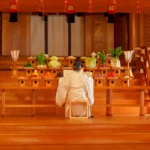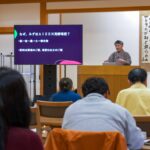By Ruth Reiner
I feel I must emphasize, what might not be obvious to some non – Japanese readers: generally in Japanese society, there is usually powerful pressure not to stand out, not to be different. Keeping this idea in mind is very important, to get a deeper understanding of how outstanding, different, courageous Onisaburo must have been. How unique, with an extreme drive that seems as if there was some great force leading him.
In his search for legal recognition for Oomoto, Onisaburo concluded that at first he should study Japanese classics and history in a recognized institute in Kyoto. After graduating from that institute, he took the Kyoto prefecture examination for the Shinto priesthood, and passed
Onisaburo served as a priest in some Shinto shrines, and even filled in some management positions, taking these experiences as a learning basis for the future. Eventually the political and social problems in Japan got so bad that Onisaburo felt he must return to the stage and take action. In 1908 he founded the Dai Nippon Shusaikai “Society for Purification and Reform of Japan”; he returned to Ayabe and began leading Oomoto’s actions.
In chapter 8 of the book, Kyotaro Deguchi, the writer, gives an introduction to his grandfather’s mysterious prophetic abilities, and I would love to share with you just a bit from Onisaburo’s publications that are mentioned, from those days. It is written so beautifully as if life were a stage (the words of a Japanese Shakespeare!?):
“…In the year of the horse, the first act will begin and with Siberian route as their hanamichi (in Kabuki, a passageway running through the audience from the theater to the stage), perverted spirits will come attacking. Exerting all their power… they will come and swallow the Land of the Gods (Japan)… here the curtain will rise on the second act…”
And so it continues telling in detail the main outlines of the Sino-Japanese war, the Russo-Japanese war and the second world war.
In 1918, Nao passed away, but this period from about 1916-1917 till 1920-1921, is mentioned in the book as “the first golden age of Oomoto”. Onisaburo came out with a few high quality publications, and started expanding the Oomoto facilities, activities, and public relations. With the popularity of Oomoto growing, so did the attacks against Oomoto grow, in the newspapers as well as from other religions.
In 1920, Onisaburo bought the Nichinichi Newspaper, one of the three leading Newspapers of that time. Onisaburo did not hesitate to give this well known newspaper an aggressive criticizing tone from the start.
It seems from the next few incidents noted in the book, that once Oomoto decided to work on the public opinion, this strong force sometimes got out of control. In chapter 11, we read about the “1921 Reconstruction Theory”. A movement involving some of the leading Oomoto people, who declared that in the year 1921: “… Divine power would manifest and bring about a reconstruction of the world…”, along with this declaration came a series of rituals, campaigns, and publishing’s nation wide, all based on interpretations of some of Oomoto’s sacred writings.
Onisaburo himself made prophesies of destruction and reconstruction, but viewed this process on a much longer scale. Eventually he wrote an assertive article announcing that he wants those who spread this theory to leave Oomoto.
Onisaburo did not ask to convince or force anyone to think his way. This in my opinion is one of the great things you find in Oomoto till this present day, the determination to follow their belief, and yet the acceptance of off-shoots of Oomoto, who decided to go their own way. I personally feel that the religions or religious leaders I truly admire understand that you can not put a “leash”, on the truth.
Oomoto was soon to storm upon the public consciousness, penetrating through many different social aspects. coming from such an ancient religion as Judaism, it is quite fascinating for me to see how in present days a new religion creates itself. Of course the historical and social background and atmosphere in Japan in the 1920’s, are not to be dismissed in terms of their importance and influence on the outcomes, eventually even tragic ones, resulting from this great wave of publicity.
Anyway, I was invited next weekend to give a speech at the city of Ayabe, (remember Ayabe?). And so. I was asked to share this speech, by some sincere readers, on next-weeks item. Flattered, I shared the idea with a co-worker in my department here at Oomoto, Mr. Yano.
Mr. Yano thought it is a brilliant idea and immediately suggested the tittle “A Coffee-Break” for next week’s item. I to think that a “Tea-ceremony-Break” seems a bit more authentic. But, I guess after all it depends what you prefer…



